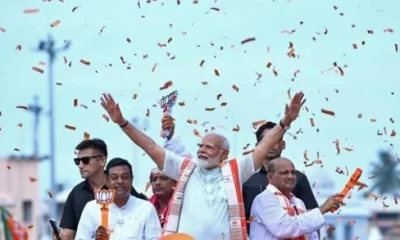Renowned American political scientist Ian Bremmer has stirred anticipation with his latest prediction regarding the BJP or Bharatiya Janata Party’s performance in the ongoing Lok Sabha elections. Bremmer’s forecast comes after Prashant Kishor’s recent assertion that the BJP could surpass its 2019 Lok Sabha elections tally, citing minimal dissatisfaction against Prime Minister Narendra Modi.
Prashant Kishor’s remarks earlier this week sparked a flurry of discussions on social media, as he suggested PM Modi’s BJP is set to return to power with either the “same or slightly better numbers.” Kishor highlighted the absence of widespread public anger against the PM or his party.
Building upon this discourse, Ian Bremmer has offered an optimistic outlook for the ruling party’s electoral prospects. Bremmer suggests that the BJP could secure between 295 and 315 seats in the Lok Sabha, potentially marking its highest-ever tally.
The BJP’s political rise has been noteworthy in recent years. In the 2014 Lok Sabha elections, the party stormed to power with 282 seats, forming the National Democratic Alliance, which secured a total of 336 seats. Subsequently, in the 2019 elections, the BJP further strengthened its position, clinching 303 seats. The NDA, led by the BJP, crossed the 350-mark, a significant electoral milestone achieved by only a select few parties in Bharat’s political history.
While the Congress-led INDIA bloc aims to dent the BJP’s support base in the Hindi heartland, the ruling party harbours aspirations of achieving the magical ‘400’ figure. The BJP is determined to maintain its stronghold in northern and western States while eyeing significant gains in southern States like Telangana, Kerala, and Tamil Nadu. Additionally, the BJP hopes to surpass its 2019 performance of 18 seats in West Bengal, signalling its intent to expand its footprint in the eastern region.
Ian Bremmer’s insightful observations shed light on the prevailing political dynamics in Bharat. Bremmer noted a remarkable stability and predictability in the Indian political landscape, attributing it to PM Modi’s strong economic performance and consistent reform initiatives. He asserted that Modi’s leadership is likely to secure a third term, buoyed by Bharat’s projected ascent as the world’s fourth-largest economy next year, and potentially the third largest by 2028.
In a global context fraught with geopolitical uncertainties and challenges to globalisation, Bremmer highlighted the relative stability of the Indian electoral process. He projected the Indian elections as a beacon of consistency amidst macro-level geopolitical turbulence, where issues such as US-China relations, global conflicts, and the upcoming US election are contributing to heightened uncertainties. Against this backdrop, the Indian elections emerge as a stable and consistent political phenomenon, providing a sense of reassurance amidst global volatility.
As the world watches, the unfolding drama of Indian democracy takes centre stage, offering a glimpse into a political landscape characterised by ambition, competition, and the promise of continuity amidst global flux.

















